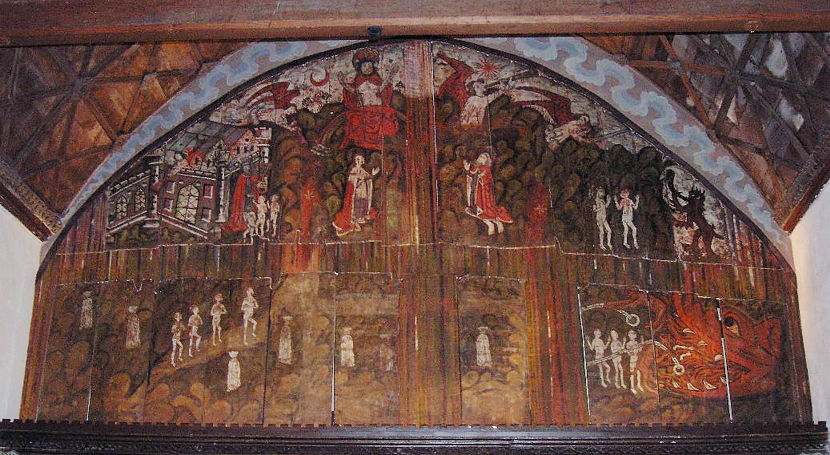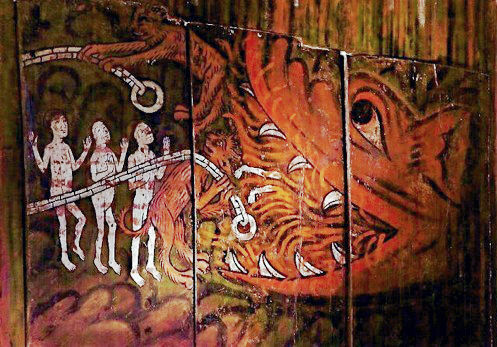Dauntsey, Wiltshire (†Bristol) c.1480
Doom (painted on boards)

This very large Doom must have been the pride and joy of Dauntsey church when it was first painted. Like the Doom at Wenhaston in Suffolk, and like one or two others in England, it is painted on boards shaped to fit under the chancel arch.
At the top an arc of illusionistic clouds painted in pale grey defines the space,and the events of the Last Day are narrated below this (do not be misled by the apparent proximity of the wooden beam in the foreground of the photograph – this is actually some distance further back towards the west end of the church and a piece of dark metal about halfway along it probably indicates the position of an early light).
At the extreme left in the upper part of the painting a glorious jumble of medieval architecture delineates the apartments of Heaven, imagined here as an ecclesiastical building with mullioned windows and turrets. An angel, very hard to see against the wealth of building detail, sounds one of the trumpets of Doom. St Peter, in a red robe, stands in the wide gateway to welcome three small naked people into the Heavenly realm.
Moving to the right, the judging Christ sits on a rainbow as usual, the crescent moon, along with another barely visible trumpeting angel in red beside him at his left. He has the three-lobed halo appropriate to the Trinity and holds up his still-bleeding arms to show his wounds.
Directly below Christ, the Virgin Mary kneels, hands held out in supplication for the rising souls. A flat board divides the painting at this point, and on the right-hand side of it kneels John the Evangelist (or possibly John the Baptist – it is hard to be sure, in a similarly supplicating attitude to the Virgin, with the rayed sun above at the top of this tier of painting. Standing figures in red flank both the Virgin and St John, and both seem to be singled out as particularly significant. Who they are, though, is well-nigh impossible to guess at now. Two much clearer angels are visible on this side, one also sounding a trumpet, and a crowd of risen souls, some, I think with crowns or mitres, cluster around, although it is very hard to distinguish any individual figure here.
Further right, an angel brandishes a threatening sword above two small naked figures (also in high-status headgear, I think),and finally comes an unpleasant black devil who blows a horn and may be pulling another miscreant by the arm. These people seem undoubtedly destined for Hell.

Directly below is the mouth of Hell itself, shown in the traditional manner as the toothed mouth of a whale-like sea-creature, with one huge eye also showing. I think I can detect a few dismembered body-parts inside the mouth itself, which would not be surprising.
Two red devils, one above and one below, are about to secure a chain around a group of people – three of them visible but others probably implied – whose final destination this is.
Moving back to the left now, three shrouded corpses, their shrouds knotted on top of the head in the standard medieval manner are visible against the rather murky background. Further left, four naked figures make their way along an ascending path in the direction of St Peter above, and at the furthest left are two more still-shrouded souls.
All in all, the Dauntsey Doom is a fine example of how English people thought about Death, Hell, Heaven and Judgement in the latter half of the fifteenth century. Rustic it certainly is, but, as with many provincial paintings of this subject, it has tremendous energy and verve despite its lack of painterly accomplishment. Fitting all the individual scenes around the timbering was quite an achievement in itself. Wiltshire suffered a wave of destruction of wall paintings in the 19th century, particularly in the Winterbourne villages, so it is remarkable that this Doom has survived to be restored.